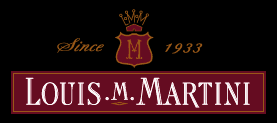|
|

theCompass mobile application is a winery, brewery, and distillery locator for North America. |
|
|
Louis M. Martini Winery

|
|
The Martini family has always placed great stock in their vineyards, and through three generations they have worked under the guiding principle that fine wine starts in the vineyard. Today, the family owns more than 600 acres of vineyards in Napa and Sonoma counties, supplying about 75 percent of the grapes used in making Louis M. Martini wines. Located in such renowned appellations as Russian River Valley, Sonoma Valley and Chiles Valley, the Martini vineyards represent decades of painstaking research by the Martini family to identify and propagate superior grape clones and to match specific grape varieties to microclimates and soils. Four Martini vineyards lie within a 25-mile radius of the winery in St. Helena. The oldest and most famous is Monte Rosso, a 250-acre ranch in the mountains of Sonoma Valley. Del Rio is a 172 acre vineyard south of Healdsburg in the Russian River Valley. In the Napa Valley, the Martini family owns the 185-acre Ghost Pines Vineyard in the newly-created Chiles Valley appellation, as well as 220 acres of land in Pope Valley, of which about 50 acres have been planted. A small Petite Sirah vineyard is also planted behind the winery.
|
|
|
Directions
We are located on Highway 29, one mile south of the town of St. Helena.
View Map
|
View Weather
Del Rio Chardonnay
|
Del Rio Gewurztraminer
Using a wide variety of clones, the Martini family planted Gewurztraminer at Monte Rosso Vineyard in 1943. During harvest five years later, Louis P. Martini walked the vineyard and tasted fruit from every vine before picking. He pounded a nail atop the stake of the ones that were truest to variety in spice and the litchi nut character. He continued this process for two more years, removing the nail if it wasn’t true and adding another if it was. In the early 1960s Louis did the process twice more to select the clones planted at Del Rio Vineyard; thus the name, 5 Nail Selection.
|
Louis M. Martini Alexander Valley Cabernet Sauvignon
A majority of the fruit is sourced from our Barrelli Creek vineyard in the Alexander Valley, which is a warmer climate growing area that produces some of the world’s most beautiful expressions of Cabernet Sauvignon. The growing season saw these grapes harvested at optimum ripeness during September and into October with an average of 24.5 brix at harvest. Picking took place in the early morning to keep the fruit as cool as possible for fermentation. Grapes were de-stemmed, but not crushed upon arrival at the winery leaving over 90% whole berries. This process allows us to better retain the grape's varietal essence and minimize bitter tannin extraction in the wine. The Cabernet Sauvignon juice was fermented with a temperature range of 76°F-85°F, receiving extended skin contact for an optimum of 21 days for maximum extraction of color and flavor. To ensure the development of desired flavor and aroma characteristics, the juice was inoculated with Prise de Mousse yeast to complete fermentation and 100% of the wine completed malolactic fermentation. Racking took place every 4-6 months with topping every four weeks.
|
Louis M. Martini Napa Valley Cabernet Sauvignon
The growing season saw these grapes harvested at optimum ripeness during September and into October with an average of 24.5 brix. Picking took place in the early morning to keep the fruit as cool as possible. Upon arrival at the winery the grapes for this wine were de-stemmed, but not crushed, leaving over 90% whole berries. The Cabernet Sauvignon juice was fermented with temperatures controlled between 76°F-85°F receiving extended skin contact up to 21 days for maximum extraction. 85% of the wine was transferred to French and European oak barrels and aged for 11 months, where the wine completed malolactic fermentation. The wine was racked every 3-4 months prior to bottling, and bottle aged at an optimum of 6 months before release.
|
Louis M. Martini Sonoma County Cabernet Sauvignon
The 2003 Louis M. Martini Sonoma County Cabernet Sauvignon was made to highlight the high quality of its fruit. It offers aromas of red cherry and blackberry that are supported by a round, sweet mouth feel with just enough structure to lead it into a fruit-focused finish.
|
Louis M. Martini Sonoma County Cabernet Sauvignon
Grapes from several Sonoma County Cabernet Sauvignon vineyards contributed to the final balanced blend of this wine. A relatively short growing season saw these grapes harvested in September and early October at 24 to 24.5 brix.
The grapes were destemmed, but not crushed, and 20 to 30 per cent of the grapes went whole into fermentation. Two days of cold soaking were followed by up to a week of active fermentation at 85 to 88 degrees Fahrenheit. Several different strains of yeast were used, each to complement different characteristics in wine.
The wine was aged in the traditional fashion, in small oak barrels from several French and American coopers. The resulting wine is complex but approachable, ready to drink now or put away for a few years.
|
Louis M. Martini Sonoma Valley Monte Rosso Cabernet Sauvignon
cool as possible. We then de-stemmed the berries directly to a tank upon arrival at the winery but did not crush them, leaving more than 90% whole berries in the fermentor. The must saw 21 days of skin contact for maximum extraction of color and flavor. The wine was aged in new and used oak barrels for an average of 18 months, where it underwent complete malolactic fermentation.
|
Louis M. Martini Sonoma Valley Monte Rosso Gnarly Vine® Zinfandel
The wine’s concentration indicates great aging potential. Ripe berry, black and white pepper, plum, coffee, vanillin and cocoa describes its thick aromatic profile. Flavors are filled with black fruit, chocolate, raspberry and espresso bean with a sinewy, full bodied mouth that covers every taste bud.
|
Napa Valley Chardonnay
|
Add New Review
|
|